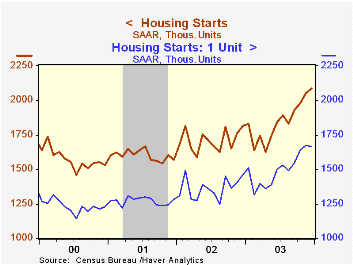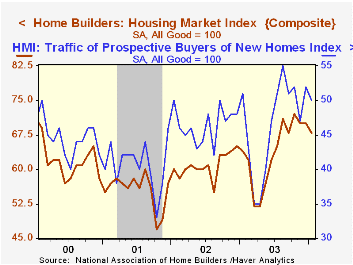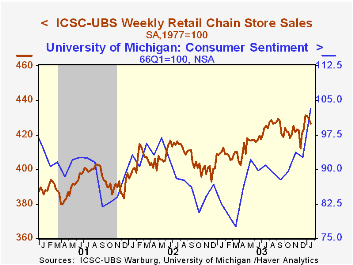 Global| Jan 21 2004
Global| Jan 21 2004Housing Starts Strong
by:Tom Moeller
|in:Economy in Brief
Summary
Housing starts added another 1.7% in December, rising to the highest level since February 1984. Consensus forecasts had been for a moderate decline versus November which was revised down. For the year, 2003 was the strongest for [...]

Housing starts added another 1.7% in December, rising to the highest level since February 1984. Consensus forecasts had been for a moderate decline versus November which was revised down.
For the year, 2003 was the strongest for housing starts since 1978.
Single family starts fell a slight 0.6% last month following a downwardly revised gain in November. Single family starts in 2003 were a record 1,501 million, up 10.0% y/y.
Multi-family starts jumped 11.6% in December following a 12.8% gain the prior month. Multi-family starts last year were the highest since 1989.
Housing starts fell m/m in the Northeast (11.1% y/y) and in the Midwest (2.6% y/y). Starts were up m/m in the South (21.3% y/y) and in the West (16.0% y/y).
Building permits rose 3.3% m/m and were up 4.5% for 2003.
| Housing Starts (000s, AR) | Dec | Nov | Y/Y | 2003 | 2002 | 2001 |
|---|---|---|---|---|---|---|
| Total | 2,088 | 2,054 | 15.0% | 1,850 | 1,711 | 1,601 |
| Single-family | 1,664 | 1,674 | 13.8% | 1,501 | 1,364 | 1,272 |
| Multi-family | 424 | 389 | 20.1% | 349 | 347 | 330 |
| Building Permits | 1,924 | 1,863 | 0.9% | 1,829 | 1,750 | 1,637 |
by Tom Moeller January 21, 2004

The National Association of Home Builders (NAHB) reported that their Composite Housing Market Index fell moderately in January to 68 (+6.3% y/y).
During the last fifteen years there has been a 79% correlation between the y/y change in the NAHB index and the change in single family housing starts.
The index of current market conditions for home sales fell 3.9% m/m to 74 (+7.2% y/y), the lowest level since September.
The index which measures expected home sales in six months also fell to the lowest level since July.
Traffic of prospective buyers fell moderately.
The NAHB index is a diffusion index based on a survey of builders. Readings above 50 signal that more builders view conditions as good than poor.
Visit the National Association of Home Builders using this link.
| Nat'l Association of Home Builders | Jan | Dec | Y/Y | 2003 | 2002 | 2001 |
|---|---|---|---|---|---|---|
| Composite Housing Market Index | 68 | 70 | 64 | 64 | 61 | 56 |
by Tom Moeller January 21, 2004

The index of mortgage applications compiled by the Mortgage Bankers Association surged 30.4% last week (-16.7% y/y) to the highest level in since early August.
The surge was driven by a 51.5% w/w spike in applications to refinance (-38.8% y/y).
Analysis titled "After the Refinancing Boom: Will Consumers Scale Back Their Spending?" from the Federal Reserve Bank of New York is available here.
The effective interest rate on a conventional 30-Year mortgage fell slightly to 5.82% from 5.84% the prior week and versus 5.97% averaged last year. The effective rate on a 15-year mortgage fell to 5.17%.
Purchase applications also were strong last week and rose 12.5% (+41.2% y/y).
During the last ten years there has been a 54% correlation between the y/y change in purchase applications and the change in new plus existing home sales.
The Mortgage Bankers Association surveys between 20 to 35 of the top lenders in the U.S. housing industry to derive its refinance, purchase and market indexes. The weekly survey accounts for more than 40% of all applications processed each week by mortgage lenders. Visit the Mortgage Bankers Association site here.
| MBA Mortgage Applications (3/16/90=100) | 1/16/04 | 1/09/03 | 2003 | 2002 | 2001 |
|---|---|---|---|---|---|
| Total Market Index | 916.1 | 702.6 | 1,067.9 | 799.7 | 625.6 |
| Purchase | 501.6 | 445.9 | 395.1 | 354.7 | 304.9 |
| Refinancing | 3,327.3 | 2,195.7 | 4,981.8 | 3,388.0 | 2,491.0 |
by Tom Moeller January 21, 2004

Chain store sales fell 0.7% last week and were down for the third consecutive period according to the ICSC-UBS survey.
Because of a strong end to December, the level of sales so far in January are up 1.6% versus last month.
During the last five years there has been a 61% correlation between the year-to-year percent change in the ICSC-UBS measure of chain store sales and the change in non-auto retail sales less gasoline.
The ICSC-UBS retail chain-store sales index is constructed using the same-store sales reported by 78 stores of seven retailers: Dayton Hudson, Federated, Kmart, May, J.C. Penney, Sears and Wal-Mart.
| ICSC-UBS (SA, 1977=100) | 01/17/04 | 01/10/04 | Y/Y | 2003 | 2002 | 2001 |
|---|---|---|---|---|---|---|
| Total Weekly Retail Chain Store Sales | 426.4 | 429.2 | 3.9% | 2.9% | 3.6% | 2.1% |
Tom Moeller
AuthorMore in Author Profile »Prior to joining Haver Analytics in 2000, Mr. Moeller worked as the Economist at Chancellor Capital Management from 1985 to 1999. There, he developed comprehensive economic forecasts and interpreted economic data for equity and fixed income portfolio managers. Also at Chancellor, Mr. Moeller worked as an equity analyst and was responsible for researching and rating companies in the economically sensitive automobile and housing industries for investment in Chancellor’s equity portfolio. Prior to joining Chancellor, Mr. Moeller was an Economist at Citibank from 1979 to 1984. He also analyzed pricing behavior in the metals industry for the Council on Wage and Price Stability in Washington, D.C. In 1999, Mr. Moeller received the award for most accurate forecast from the Forecasters' Club of New York. From 1990 to 1992 he was President of the New York Association for Business Economists. Mr. Moeller earned an M.B.A. in Finance from Fordham University, where he graduated in 1987. He holds a Bachelor of Arts in Economics from George Washington University.






